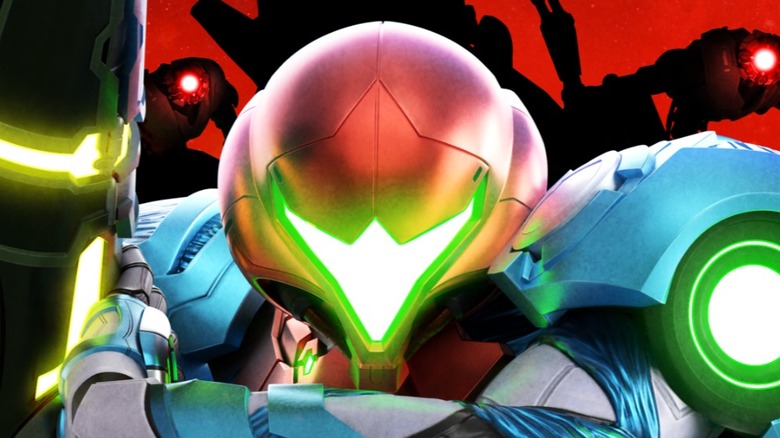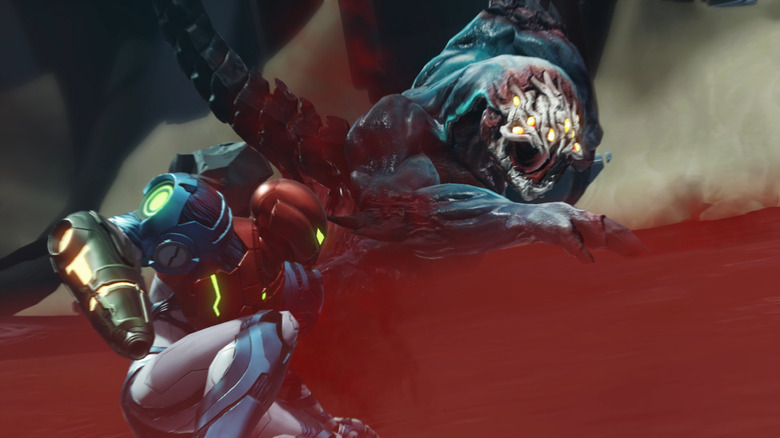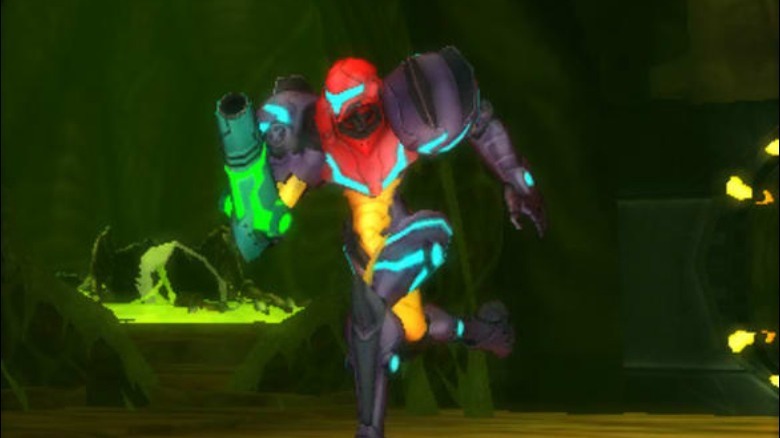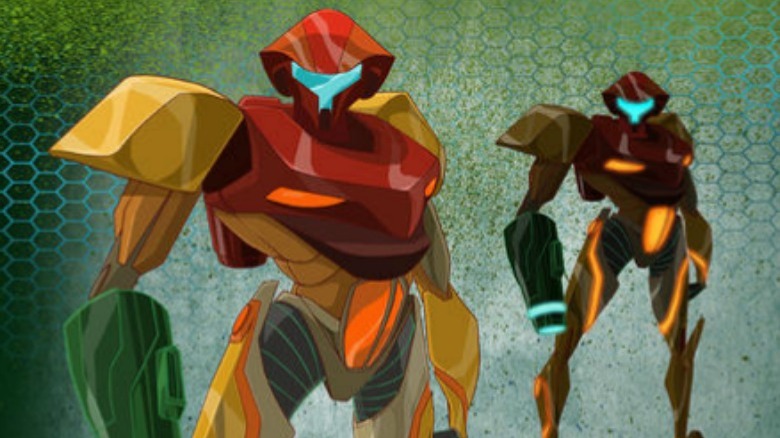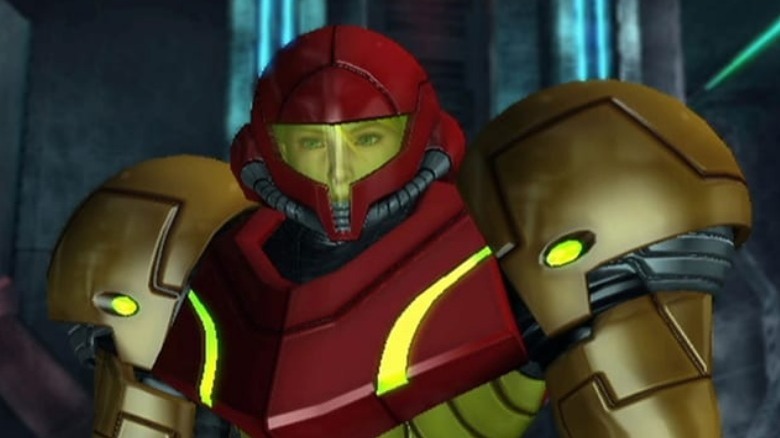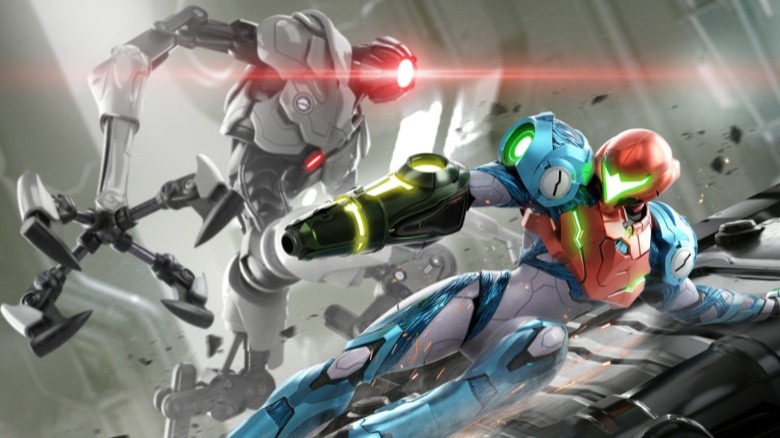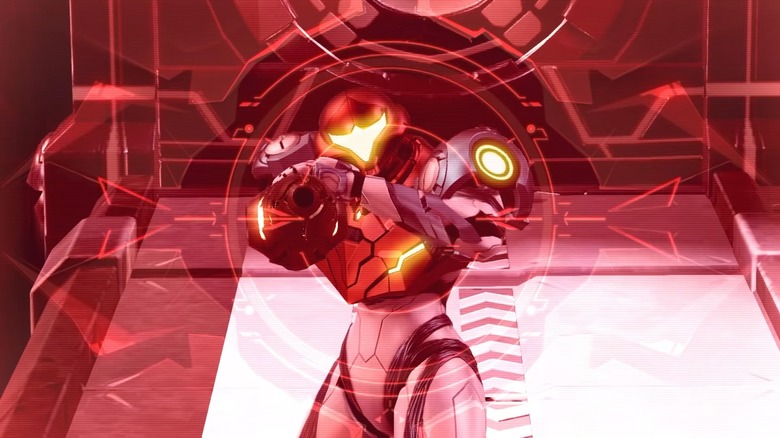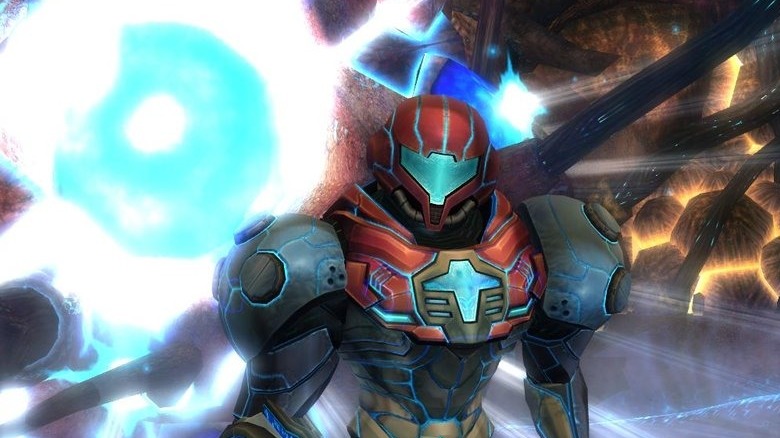The Untold Truth Of Metroid Dread
Almost every year, Nintendo announces a new "Super Mario," "Legend of Zelda," or "Fire Emblem" game, but new entries in franchises such as "Star Fox," "F-Zero," and "Metroid" are rare. "F-Zero" seemingly only lives on through Captain Falcon's permanent placement in "Super Smash Bros.," while the last "Star Fox" game was the disastrous "Star Fox Zero." On the other hand, "Metroid" has received the most attention out of these oft-forgotten franchises, with the newest entry being 2021's "Metroid Dread," a long-rumored return to the franchise's 2D roots.
The announcement for "Dread" came as a surprise to most E3 virtual attendees. After all, in 2017, Nintendo revealed "Metroid Prime 4," and two years later, the company announced the game's development would restart under the banner of Retro Studios. Most viewers assumed E3 2021 would be prime real estate for more news, but instead, Nintendo left them stunned with the reveal of "Dread."
Nonetheless, different audience members were shocked for different reasons. Some were astonished because they thought Nintendo had abandoned the old 2D style (the company hadn't released a side-scrolling "Metroid” title in almost two decades, not counting remakes), while others had assumed "Dread" was lost in development limbo and would never resurface.
Yes, some iteration of "Metroid Dread" has been in the pipeline longer than "Metroid: Other M" or "Metroid: Samus Returns." That lengthy gestation period also belies a bevy of untold truths that otherwise might be lost to the digital annals of time.
A game 15 years in the making
Nintendo has this weird tendency to start producing a game with a specific console in mind, only to release the title on a successor console. The underrated "Eternal Darkness: Sanity's Requiem," for example, was initially announced for the Nintendo 64. "Metroid Dread," meanwhile, was supposed to launch several console generations ago on the Nintendo DS, but it clawed its way out of two cancelations to grace the Nintendo Switch.
Word of "Metroid Dread" can be found as early as 2005, when IGN obtained an internal Nintendo document that listed several in-development games for the DS. According to the outlet, every game on the list was eventually released, except for "Dread." Nobody knew if the title was canceled since Nintendo never officially acknowledged it until 2021. Recently, however, the producer of "Dread," Yoshio Sakamoto, confirmed that the game had been canceled, subsequently revived several years later (Eurogamer places the second attempt around 2008) and then canceled once more.
While it's rare for canceled games to be resurrected (and even rarer for the revivals to be buried and then dug up again), these projects usually undergo some sort of drastic metamorphosis. Not "Metroid Dread," however. According to Sakamoto, again via Eurogamer, "Dread" began life as a simple concept: "Samus facing a dreadful opponent, a dreadful experience."
That core vision remained unchanged throughout the game's development hell, even though its official title was more malleable. According to Unseen 64 archivist Liam Robertson, the 2008 iteration briefly dropped "Dread" from its title.
When dreams exceed technology
Video games can be canceled for any number of reasons. Sometimes, studios run out of money; other times, a marriage between two companies ends in a messy divorce that leaves their games abandoned. However, "Metroid Dread" was initially canceled because Yoshio Sakamoto realized that the platform he originally envisioned for the game couldn't live up to the task at hand.
When Nintendo announced "Dread" during E3 2021, the company touted the game as its most important title of the event — an honor usually reserved for "Super Smash Bros. Ultimate" DLC. Not only that, but Nintendo aired its dirty development history laundry, which is highly unusual. During the "Development History" video, Sakamoto stated that the first version of "Dread," which was meant for the Nintendo DS, had to be canceled because he thought the technology on hand couldn't "properly bring the concept to life."
When Sakamoto and his team gave "Dread" another go, they canceled the title once again because they "couldn't create the game as originally imagined." In other words, "Dread" was too ambitious for its time. However, technology has advanced in leaps and bounds, and what was once impossible for video games is now commonplace.
Sakamoto was ready to give up any hope of publishing "Dread," but then MercurySteam leapt onto the stage. The company blew Sakamoto away with "Metroid: Samus Returns," and he believed he found the studio to bring his "Dread" dreams to life. He didn't know the half of it, as Sakamoto claims "Metroid Dread" in its current iteration "surpasses" his vision from 15 years ago.
Numerous false starts means numerous development studios
Even though Nintendo is best known for its first-party games, it's easy to forget that many aren't developed by first-party studios. For instance, Nintendo produced "Luigi's Mansion" in-house, but sequel development duties fell to Next Level Games. Likewise, MercurySteam is making "Metroid Dread" because the company impressed Yoshio Sakamoto with "Metroid: Samus Returns." But, therein lies an important question: If "Dread" development predates "Samus Returns," then who produced the 2005 and 2008 iterations of "Dread?"
While it's unclear who worked on the canceled versions of "Metroid Dread," fans do know who almost worked on them. One of the most promising early candidates was Nintendo Software Technology (NST), which previously developed "Metroid Prime Hunters" (via Liam Robertson). While Nintendo allegedly used "Prime Hunters" as a barometer to gauge NST's potential, Nintendo eventually dropped NST (and possibly all development of "Dread") in the aftermath of the "Project H.A.M.M.E.R." debacle, during which a major NST title was canceled amidst internal conflicts.
On a side note, Next Level Games once tried its hand at "Metroid" prior to developing "Federation Force." During an old Iwata Asks segment, Audio Director Chad York claimed Next Level Games had prepared a prototype shortly before a decisive meeting with Nintendo. Rumor has it the prototype was for a potential "Metroid" game, backed up by concept art from an ex-Next Level Games artist. Had history traveled another path, Next Level Games could have produced "Metroid Dread," rather than "Luigi's Mansion 2."
Why is Dread only considered the fifth in the franchise?
A proper numbering convention can turn a confusing franchise into an approachable one. For example, if you only play the three main "Kingdom Hearts" titles, you won't understand the overarching narrative at all; you need to play intergrade entries such as "358/2 Days" and "Birth by Sleep" to get the full story.
The reverse applies to "Metroid Dread." The game's announcement trailer initially introduced the title as "Metroid 5." But, there are more than five "Metroid" games, remakes notwithstanding. Why aren't "Other M" or the "Prime" entries accounted for in that numbering? There's a simple explanation for that.
According to Yoshio Sakamoto (via Nintendo's "Development History" video), "Metroid Dread" is the fifth entry in an arc that explored the "uncanny relationship" between Samus Aran and the Metroids. The arc started with "Metroid" and "Metroid 2: The Return of Samus," where Samus hunted Metroids to the point of extinction. Then, she had to rescue the final surviving Metroid in "Super Metroid" (a.k.a. "Metroid 3"), and its DNA was used to save her from the X Parasite — and create clone Metroids — in "Metroid Fusion" (or "Metroid 4"). This bond will come to a head in "Metroid Dread," a.k.a. "Metroid 5." Essentially, "Other M" and "Prime" are side stories.
Sakamoto wants "Metroid Dread" to mark the end of the aforementioned arc. He doesn't want to stop making "Metroid" games, just close the book on the Metroid/Samus story seven console generations in the making.
This isn't the first time audiences have seen a live Chozo
The Chozo are an essential part of "Metroid" lore. They adopted Samus Aran and built her iconic Power Suit, and they also created Metroids, Mother Brain, and other genetically engineered creatures that have since tried to kill Samus. The Chozo are supposed to be extinct, but the "Metroid Dread" trailer features a series first in the form of what appears to be a living, breathing Chozo. Or does it?
Actually, the trailer isn't the first time audiences have seen this character, or to be more specific, the first time completionists have seen this character. In "Metroid: Samus Returns," players can unlock a special gallery called "Chozo Memories" by finding every collectible. The gallery shows the Chozo landing on the planet SR388, encountering the X Parasites, and creating the Metroids; all common knowledge to "Metroid" fans. But, the final two images portray an unnamed Chozo, dubbed the Chozo General, meeting the colonists and ... slaughtering them in clear contradiction to their traditionally sagely depictions. Judging by its ornate outfit and the orbs embedded in its pauldrons, this Chozo General is the same Chozo from the "Dread" trailer.
Assuming they are the same Chozo, the announcement trailer didn't just show off a living example of a Chozo; it might have teased the game's main villain — one that only the most dedicated "Samus Returns" players would be familiar with.
Just what is an E.M.M.I?
The "Metroid" franchise has a fairly reliable roster of enemies. There's recurring faces such as the Metroids and Ridley, as well as one-offs like Crocomire and the SA-X. The E.M.M.I. bots are the latest additions to Samus Aran's rogues' gallery, and they are more than just terrifying enemies designed to make players run around like headless chickens.
At first glance, the E.M.M.I. seem like relentless assassin droids that can show up at any time, any place and hound Samus Aran with the tenacity of a T-800. In truth, E.M.M.I. are actually research robots designed to collect DNA samples via giant, scary spikes that erupt from their faces. Moreover, E.M.M.I. apparently aren't as unpredictable as the trailers make them seem. Sure, E.M.M.I. can pop out of doors to give players a heart attack, but only in set locations. The "Metroid Dread" Nintendo Treehouse video demonstrates that players will only encounter E.M.M.I. in special areas, which are denoted by creepy music and pixelated doors.
If E.M.M.I. pursuits give you SA-X flashbacks, that is by design. Yoshio Sakamoto told Polygon that the heartless doppelganger from "Fusion" was a major inspiration for the E.M.M.I. However, gameplay demos demonstrate that the robots are much more proactive and intelligent than the SA-X, so don't expect an E.M.M.I. to give up just because you hide behind an easily scalable wall.
Dread is supposed to be horrifying, not a horror game
The previous mainline "Metroid" games have done their best to make audiences sweat. The SA-X terrified many gamers the first time they encountered it, and Yoshio Sakamoto explained (via the "Development History" video) that "Metroid Dread" will include "new elements of a different flavor." Add in an admission that "Dread" in the title is meant to represent a "relentless threat" that "haunts [Samus'] every move," and you might assume the game is designed as a horror experience. It isn't.
Sakamoto told outlets such as IGN that "fear" is the main theme of "Dread" because Samus Aran is supposed to overcome it. In the game, Samus "stands against that fear and fights it and beats it." She is, after all, the "consummate professional warrior."
Moreover, while the E.M.M.I. are designed as these unsettling, calculating enemies that cannot be reasoned or bargained with, "Dread" throws audiences a bone while facing them. Normally, when players die in a "Metroid" game, they are booted back to a save room, but in a series first, if someone is caught by an E.M.M.I., they get to start from a checkpoint outside the robot's patrol area. At its heart, "Metroid Dread" is still a metroidvania title and not a survival horror game, no matter how much a pursuing E.M.M.I. makes you want to scream like PewDiePie.
Sometimes a reference is just a reference
Usually, Easter eggs in video games are cute nods that reference popular media (or anything the developers like), or are otherwise good-natured ribbings. However, sometimes an Easter egg provides hints of titles yet to come — or at least that's what some gamers like to think.
Now, the "Metroid" series isn't known for having a ton of Easter eggs, but audiences thought they found one in "Metroid Prime 3: Corruption." In that game, players can uncover a Space Pirate log that reads: "Experiment status report update. Metroid project 'Dread' is nearing the final stages of completion." At that time, since development of "Metroid Dread" was semi-common knowledge, audiences assumed the Space Pirate message was hinting that "Dread" would soon be released, no matter how much Nintendo denied the game's existence.
While history eventually proved that "Metroid Dread" was nowhere near completion when "Prime 3" launched, wouldn't that at least mean the Easter egg indicated Retro Studios' developers thought "Dread" would be releasing soon? Well, that would only work if the "Metroid project 'Dread'" log was an actual Easter egg to begin with.
In 2007, Game Director Mark Pacini told MTV that the "Metroid project 'Dread'" entry was nothing but a coincidence. However, Senior Game Designer Mike Wilkan later claimed it wasn't a coincidence, but rather an inside joke. Well, almost 15 years later, audiences will finally get the last laugh, because the real Metroid project "Dread" will launch Oct. 8, 2021.

